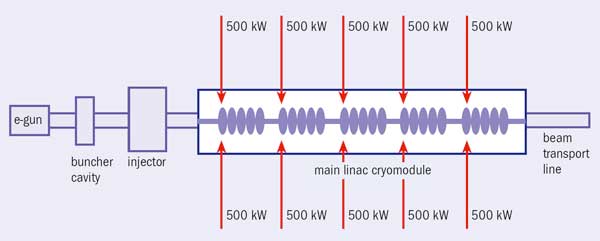
In late 2007, owing to an extended shutdown of Canada’s National Research Universal (NRU) reactor at Chalk River, North America experienced a critical shortage of the medical isotope molybdenum-99 (99Mo). Currently some 80–85% of the 40 million nuclear-medicine procedures worldwide each year use 99Mo. The NRU reactor, which has been operating since 1957, produces about half of the world’s supply. A second reactor in the Netherlands produces the balance. It too has suffered from age-related shutdowns.
The 99Mo isotope has traditionally been manufactured using nuclear reactors to irradiate highly enriched uranium targets because high neutron fluxes are available. Now, in the light of advances in accelerators – particularly in superconducting RF (SRF) cavities that enable high beam power (Superconducting RF success) – TRIUMF, Canada’s national laboratory for particle and nuclear physics, has led a study of alternative techniques for producing 99Mo. The North American study group that was convened by TRIUMF included physics and chemistry experts, as well as clinical professionals representing industry.

The most favoured approach uses photons from a high-power electron linear accelerator to produce 99Mo from natural uranium. The researchers concluded that significant quantities of 99Mo can be produced using this method, although several laboratory experiments will be needed to establish efficiencies, equivalency of products, reliability of operation and capacity. A single multimegawatt machine could supply the entire Canadian market or 5–7% of the total North American market. The radiochemistry needed to recover and refine the 99Mo generated through photofission from natural uranium targets is likely to resemble that which is currently in use for reactors using highly enriched uranium targets. The similarity of the initial 99Mo-recovery step will depend on the volume of the target for photofission, which relies in detail on the optimization of design and performance parameters. The study group recommended the formation of a steering group, which would oversee laboratory demonstrations of the entire process, ultimately leading to a full-scale design process.
The study has attracted widespread interest in Europe, Asia and North America, with each region investigating options for securing a reliable supply of 99Mo. In many cases, however, these are highly dependent on the future plans for nuclear power, because manufacturers of power plants are likely to construct and operate their own research reactors. Canada’s five-year plan for TRIUMF (2010–2015) already includes the construction and operation of a high-power electron linear accelerator using SRF. This machine could be an important testbed for the proposed 99Mo technology because it will operate at similar power densities.
Further reading
• For more about the Canadian task force on alternatives for medical isotope production, see http://admin.triumf.ca/facility/5yp/comm/isotope-task-force.php.








